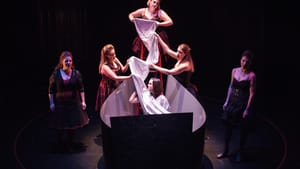Stay in the Loop
BSR publishes on a weekly schedule, with an email newsletter every Wednesday and Thursday morning. There’s no paywall, and subscribing is always free.
A Balkan bachelorette party
'Svadba-Wedding' by Opera Philadelphia (1st review)

Way back in 1913, Igor Stravinsky started writing The Wedding, titled Les Noces in French, the language Stravinsky was using then. This follow-up to his Sacre du Printemps was a choral composition using Russian peasant folk songs about weddings, much of the text stressing a woman's duty to marry and the restrictive aspects of the institution.
Almost a century later the Serbian-Canadian Ana Sokolovic composed this Balkan version of the same setting. Her text is based on the folk traditions of various countries in the region, primarily her native Serbia. As in Stravinsky’s work, we hear the anxiety of leaving behind one’s freedom and starting a new family.
A different take
There are significant differences between Stravinsky’s piece and Sokolovic’s. The Russian wrote a score for four pianos plus percussion. (The American premiere, with composer-pianists Aaron Copland, Marc Blitzstein, Louis Gruenberg and Frederick Jacobi, was conducted by Leopold Stokowski). Sokolovic, on the other hand, has her vocalists sing virtually a capella, with only an ocarina, rainstick or glockenspiel to add color.
Also, Stravinsky followed an entire wedding, while Svadba concentrates on the bachelorette gathering the night before. Milica, the bride, is surrounded by her girlfriends, who help her prepare her hair and dress as they remember happy times and express sadness about the changes to come.
Les Noces, which premiered at the Ballet Russe, used a company of 60 dancers, while Svadba has six singers providing all the physical movements. As they moved around the wide stage they stayed remarkably together in their harmonizing and in the details of their contrapuntal interplay. Sopranos Jacqueline Woodley, Shannon Mercer, Virginia Hatfield and Laura Albino and mezzo-sopranos Andrea Ludwig and Krisztina Szabó were the superb ensemble. All of them have backgrounds in opera, but they were totally believable as Balkan peasant women.
A Balkan blend
Much of their music was mesmerizingly soft and lovely; other parts used the glottal stops and guttural trills often heard in African and Arabic cultures. Out of place? No — Islam has a strong presence in the Balkans and a third of the area’s Roma (gypsy) people are Muslim. The singing also included some half-sharp and half-flat tones that lie outside normal Western scales.
This was the first in Opera Philadelphia's new Opera in the City series, intended to show untraditional operas in unusual venues, in this case the new FringeArts headquarters at Race Street and Columbus Boulevard. Part of what made it untraditional was what happened after the 50-minute performance: a 10-person Balkan orchestra, led by tuba and baritones, came onstage and started a procession toward a wedding party, featuring traditional cuisine and dancing, in an adjoining room.
Dáirine Ní Mheadhra conducted commandingly and Marie-Josée Chartier directed, as they had at the work’s premiere in Toronto in 2011.
To read another review by Peter Burwasser, click here.
What, When, Where
Svadba-Wedding. Opera by Ana Sokolovic. Produced by Opera Philadelphia. Dáirine Ní Mheadhra conducted. November 2-7, 2013 at FringeArts, 140 N. Columbus Boulevard (at Race Street), Philadelphia. (215) 732-8400 or www.operaphila.org/production/svadba.
Sign up for our newsletter
All of the week's new articles, all in one place. Sign up for the free weekly BSR newsletters, and don't miss a conversation.
 Steve Cohen
Steve Cohen